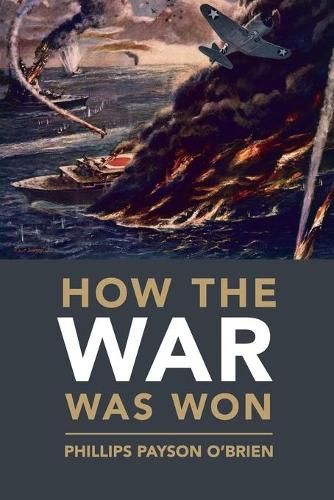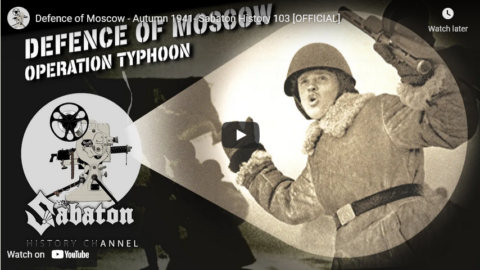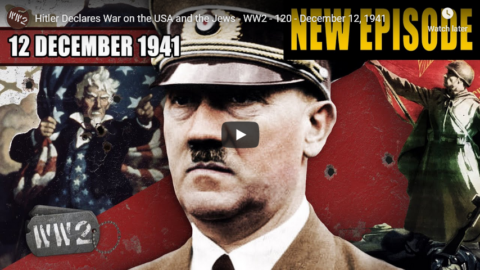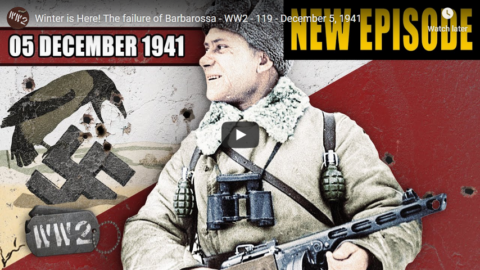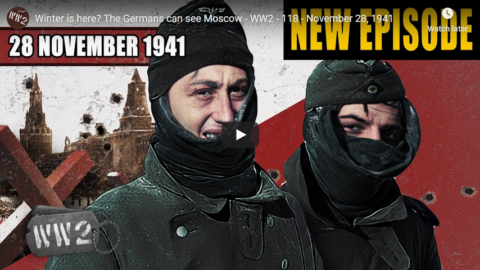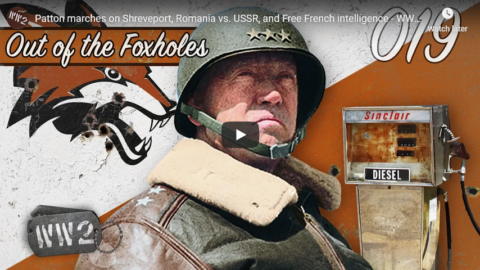Tasting History with Max Miller
Published 10 Sept 2024Vibrantly colored pumpkin and millet porridge
City/Region: Soviet Union
Time Period: 1939By the time WWII started, the Soviet Union had already been dealing with famine due to several years of poor harvests. When the German invasion and a scorched earth policy left them with only half of their farm acreage, rationing began, and even so, millions starved.
This Soviet wartime cookbook, The Book of Tasty and Healthy Food, contains mostly recipes that would’ve only been made during the best of times or by those who had access to better food. Even this simple recipe uses milk and sugar, which would have been hard to come by.
The porridge, or kasha, is filling and delicious. It’s lightly sweet from the pumpkin and sugar (though personally I would add more sugar), and the millet has a nice earthy quality. Though not very ration-friendly, you could add some butter for a bit of extra richness.
Place peeled and finely chopped pumpkin in hot milk and cook for 10 to 15 minutes, then add washed millet. Add salt, and stirring, continue cooking for another 15 to 20 minutes until thickened. Place the cooked porridge in a water bath or in the oven for 25 to 30 minutes.
— Книга о вкусной и здоровой пище (The Book of Tasty and Healthy Food), by the Institute of Nutrition, 1939
January 21, 2025
Cooking on the Soviet Home Front during WWII
October 2, 2024
QotD: Alternative history Operation Barbarossa
Trying to predict specific events is of course a mug’s game, but the trend lines are easy to spot. The danger is the nearly irresistible temptation to retcon psychological events into political decisions.
Knowing full well how dumb it is to bring up World War II on the Internet, consider that a pretty reasonable case can be constructed for Operation Barbarossa. Having purged all their competent, experienced officers, the Red Army had just gotten their clocks cleaned by the Finns in the Winter War. Yeah, the Soviets “won” in the end, but with that disparity of forces, there’s pretty much no possible “win” that doesn’t look like a loss … and the Soviets, to put it mildly, were nowhere near that best-case scenario. Moreover, even if you took the show trials for exactly that — kangaroo courts — their very existence showed there was a deep rift at the very top of the Soviet leadership. Anyone, not just Hitler, could be forgiven for thinking that the Soviet Union would collapse under one big sledgehammer blow.1
It works the other way, too. If we accept the “Suvorov Thesis”, that Hitler only attacked Stalin because Stalin was gearing up to attack Hitler, then we can easily construct a similar case from The Boss’s perspective: The Wehrmacht can’t play defense. The one time they came up against anything approaching a real opponent with technological parity (the Battle of Britain), it was at best a bloody draw, more than likely a stinging defeat. And the Hitler regime was reeling, internally. No show trials for der Führer, but Rudolf Hess, who was at least the number three man in the Reich and at the time Hitler’s heir apparent, had just defected to the British. Anyone, not just Stalin, could be forgiven for thinking that the Third Reich would collapse under one big sledgehammer blow.
See what I mean? Both of those cases are quite plausible, and fit with most known historical facts … and yet, they’re retcons. “Rationalizations” might even be a better word, because the thing is, even though those arguments are “logical”, and might indeed have been convincing to important people at the time, that’s not why Hitler did what he did, or why Stalin would’ve done what he would’ve done under the Suvorov Thesis. No, the truth is simpler, and much more horrifying: They would’ve done it anyway, because that’s who they were.
That’s what the Castle Wolfenstein people got right about the Nazis. Same deal with that Amazon show (which was interesting for a season) The Man in the High Castle. In the real world, there’s no possible way the Nazis could’ve invaded the USA, no matter how it turned out on the Eastern Front …
… but in the real world they would’ve tried nonetheless, somehow, because that’s just who they were. Everything Stalin, Khrushchev, et al did during the Cold War here in the real world, Hitler, Heydrich, and the gang would’ve done in the Castle Wolfenstein world where the Battles of Stalingrad and Kursk went the other way.2 They couldn’t have done any different, without being different people, and while it’s fun to speculate on questions like “who would’ve been the Nazi Gorbachev, who self-destructed the Reich by attempting however you say ‘perestroika‘ in German”, it’s not really germane.
Severian, “The Man in the High Chair”, Rotten Chestnuts, 2021-07-05.
1. And Soviet losses were stupendous, utterly mind-boggling, in the first few months of Barbarossa. Tanks and planes destroyed in their tens of thousands, prisoners captured in millions. Even as it became clear that OKW had underestimated Red Army strength by orders of magnitude, it was still almost inconceivable that they had anything left to fight with. Just one more push …
2. This is actually the world of a fun novel, Robert Harris’s Fatherland.
August 15, 2024
Yet another revisionist history of World War II
In the latest anonymous review at Astral Codex Ten, the book to be considered is How the War Was Won by Phillips Payson O’Brien:
To a first approximation, there are a million books about World War II. Why should you care about How the War Was Won (hereinafter “HtWWW”) by Phillips Payson O’Brien?
- It provides a new, transformative view of the conflict by focusing on production of key goods and what affected that production instead of the ups and downs of battles at the front.
- That particular lens used can (and should) be applied outside of just World War II, and you can get a feel for how that might be done by reading HtWWW.
- I have lectured about World War II and read many, many books about it. I have never texted friends more excerpts of a book than this one.
I have some criticisms of HtWWW, but if the criticisms dissuade you from reading the book, I will have failed. These complaints are like tut-tutting Einstein’s penmanship.
The Wikipedia-Level Story of World War II (and O’Brien’s Counterargument)
To understand why O’Brien’s argument is so novel, you need to know the modern-day conventional understanding of the story of World War II. Here is my summary of the conventional narrative of World War II:
- Germany conquered Poland and France. It tried to bomb the UK into submission/maybe enable an invasion. That effort failed when Germany was defeated in the Battle of Britain, thanks largely to the plucky efforts of British airmen (memorably summarized by Winston Churchill: “Never in the field of human conflict was so much owed by so many to so few”.)
- Stymied in the West, Germany invaded the Soviet Union, won a bunch of crushing victories, but then got turned back at the gates of Moscow. The Soviets moved all of their factories east of the Ural Mountains and produced a vast tide of T-34 tanks that overpowered the Germans.
- The Germans suffered a catastrophic defeat at Stalingrad and a bloody strategic defeat at Kursk, after which the Soviets relentlessly pounded Germany to defeat.
- The US and the UK sent a lot of material help and eventually fought the Germans too, most notably in the D-Day invasion and the Battle of the Bulge. However, most of the fighting was done by the Soviets.
- It is very difficult to say how important the aerial bombing campaigns of the Western Allies were in defeating Germany. The Germans moved much of their production underground, insulating them from truly disastrous effects.
- The U.S. mostly fought alone against Japan, which won a series of impressive early victories (e.g., Pearl Harbor, the conquest of Singapore) until the decisive Battle of Midway, after which the vastly larger US industrial base outproduced Japan into oblivion.
- The US bombed the Japanese into submission by destroying Japanese cities, ultimately by dropping atom bombs on Hiroshima and Nagasaki.
By examining where the Axis focused their productive capacities and how the Allies disrupted those capacities, O’Brien challenges virtually every part of that narrative:
- The Battle of Britain was not a close-run thing. The fact that British fighter planes were flying over their own territory meant their attrition rate of pilots and aircraft were far lower than the Germans’.
- American and British bombing mattered far more to the war’s outcome than the battles of the Eastern Front, which consumed a much smaller portion of German expenditures.
- American and British airpower made German battlefield victories on the Western Front virtually impossible and dramatically limited the force Germany could bring to bear in the East.
- Japan (really, Japan plus the giant empire it conquered at the beginning of the war) was an industrial behemoth to rival the Soviet Union. However, the destruction of the Japanese merchant fleet by American air and sea forces wrecked Japan’s economy.
- The firebombing of Japanese cities and the atomic bombings of Hiroshima and Nagasaki had an ambiguous strategic effect. American air power played a much more important role in severing Japan from the natural resources it had conquered in the early part of the war.
June 23, 2023
From Operation Barbarossa in 1941 to the disinformation and cover-up over the origins of the Wuhan Coronavirus
Chris Bray outlines the utterly amazing situation between the Soviet Union and Nazi Germany on the eve of Hitler launching Operation Barbarossa — where Stalin refused to believe that Hitler would attack Russia despite overwhelming evidence from many sources — to the parallel situation over Covid:
Several sources quite specifically reported to the Soviet government that the Germans would invade around dawn on June 22. Their reports can be found in the Soviet archives in a “folder of dubious and misleading reports”. Then, shortly before dawn on June 22, Germany invaded the Soviet Union. Military leaders on the border called in reports of the invasion, and the people they talked to in Moscow declined to believe them. Soviet border troops held their fire, seeing Germans while being ordered to understand that no true invasion could possibly be underway. Stalin knew better, and contradicting Josef Stalin was known to be a fatal mistake. Achieving an entirely avoidable surprise, the Germans destroyed much of the Soviet air force on the ground, parked wingtip-to-wingtip for the convenience of the invader’s bombers.
[…]
An invasion that could have been met with brutal severity from the first moment instead achieved considerable initial success against a supine nation because the Soviet leader, and the chain of subordinates beneath him who were forced to adopt his conception of facts and truth, assumed that things they didn’t wish to believe constituted disinformation. Millions of lives were wasted for that illusion. A society that categorizes inconvenient truths in this way is committing a form of suicide, hiding from hard facts that demand acknowledgment.
Now: In 2021, the lab leak theory was a disgusting lie with “racist roots”.
In June of 2023, the, uh, first people who got sick with Covid turn out to have been, uh, scientists at the lab in Wuhan. BUT THEY PROBABLY HAD SOME BAT SOUP AT THE WET MARKET, IS WHY, or something.
Stupid conspiracy theorists, you people are such MORONS, do you actually bel— okay, that one’s true too.
We’ve somehow developed an industry of professional information barriers, dimwitted parasitical human garbage whose sole function in life is to prevent understanding by pasting “disinformation” stickers on things that you’re not supposed to know.
January 7, 2023
1812/1941: Hitler’s Obsession with Napoleon’s Defeat
Real Time History
Published 6 Jan 2023When Nazi Germany attacked the Soviet Union in 1941, Napoleon’s failed campaign was on many minds. Hitler specifically wanted to avoid a repetition of 1812 and even when his luck ran out was adamant to avoid any comparisons.
(more…)
September 1, 2021
German Siege Tactics on the Eastern Front – WW2 Special
World War Two
Published 31 Aug 2021German military doctrine is all about mobility and operational maneuverability, but there comes a time in this war, well, several times, when an actual classic siege is called for. So how does the Wehrmacht respond to that call? Find out today.
(more…)
August 25, 2021
Carica! – The Cavalry Charges of World War Two – WW2 Special
World War Two
Published 24 Aug 2021The Eastern Front is a battleground of Blitzkrieg and Deep Battle; Panzers vs. T-34s; Nazism and Communism. You’d think that there would be no place for cavalry tactics here. But the Wehrmacht, Red Army, and Regio Esercito do still use centuries-old cavalry tactics in their waging of war.
(more…)
June 19, 2021
“Defence of Moscow” – Autumn 1941- Sabaton History 103
Sabaton History
Published 17 Jun 2021While it is legendary, there is a lot of confusion and a lot of myths about Operation Typhoon, the German drive on Moscow in the fall of 1941, and Operation Barbarossa, the invasion of the Soviet Union that summer. Today I talk about the first 5.5 months of Barbarossa, and then Joakim and I discuss covers and covers of covers.
Support Sabaton History on Patreon: https://www.patreon.com/sabatonhistory
Listen to “Defence Of Moscow”: https://music.sabaton.net/DefenceOfMo…
Watch the Official Music Video of “Defence Of Moscow” here: https://www.youtube.com/watch?v=i7K4v…
Listen to Sabaton on Spotify: http://smarturl.it/SabatonSpotify
Official Sabaton Merchandise Shop: http://bit.ly/SabatonOfficialShopHosted by: Indy Neidell
Written by: Markus Linke and Indy Neidell
Directed by: Astrid Deinhard and Wieke Kapteijns
Produced by: Pär Sundström, Astrid Deinhard and Spartacus Olsson
Creative Producer: Maria Kyhle
Executive Producers: Pär Sundström, Joakim Brodén, Tomas Sunmo, Indy Neidell, Astrid Deinhard, and Spartacus Olsson
Community Manager: Maria Kyhle
Post-Production Director: Wieke Kapteijns
Editor: Karolina Dołęga
Sound Editor: Marek Kaminski
Maps by: Eastory – https://www.youtube.com/c/eastory
Archive: Reuters/Screenocean – https://www.screenocean.comColorizations by:
– Mikołaj Uchmann
– Julius Jääskeläinen – https://www.facebook.com/JJcolorization/Sources:
– National Archives Nara
– Narodowe Archiwum Cyfrowe NARA
– Bundesarchiv
– New York Public Library
– Train tracks icon by Danishicon from the Noun Project
– Picture of singer Loona courtesy of Sandstein https://commons.wikimedia.org/wiki/Ca…
– Imperial War Museums: HU 75543, PST 4712
– Australian War MemorialAll music by: Sabaton
RADIO TAPOK – Битва за Москву (В стиле Sabaton / ИзиРок / – Defence Of Moscow)An OnLion Entertainment GmbH and Raging Beaver Publishing AB co-Production.
© Raging Beaver Publishing AB, 2021 – all rights reserved.
May 5, 2021
The Greatest Spy Story Almost Never Told – WW2 – Spies & Ties 02
World War Two
Published 4 May 2021A spy story almost forgotten to history that is key to understanding the espionage campaign that was waged as Hitler, Stalin, Roosevelt, and Churchill publicly directed the frontlines. Coming together here are the histories of cryptography, Nazi double-agents, and nuclear weapons.
(more…)
April 4, 2021
German railway logistical problems after Operation Barbarossa began
I was involved in a discussion on the TimeGhost Army forum on the reasons the Wehrmacht didn’t get as much use out of the existing Soviet railway system to support their forces. I ended up writing enough that I thought it’d be worth pulling together into a blog post. The original question was why didn’t the Germans build new rail lines in Poland to the Russian gauge — which was different enough from the standard 4′ 8 1/2″ gauge used in most of the rest of Europe to help supply their armies.
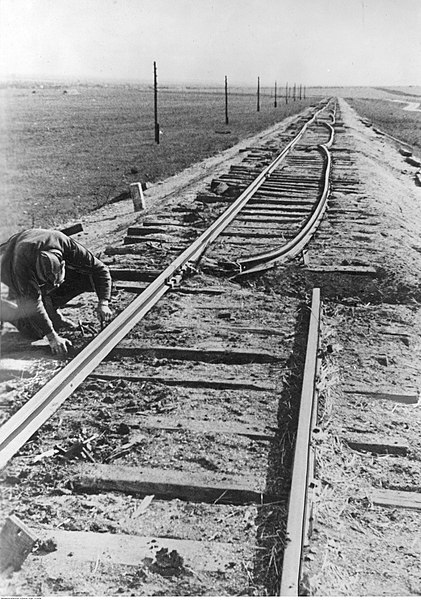
Example of the damage to Soviet railway lines conducted during the Soviet retreat in 1941.
This photo originally from Wydawnictwo Prasowe Kraków-Warszawa via Wikimedia Commons.
In Christian Wolmar’s Engines of War: How Wars Were Won and Lost on the Railways, he outlines the troubles the Germans faced after launching Operation Barbarossa with regard to logistics on the railway network. Each of the main Germany axes of advance had only one Soviet rail line to provide the bulk of the transport, but the Soviets had successfully withdrawn or destroyed the majority of the locomotives and rolling stock. German industry could have been assigned the task of producing new locomotives to fit the Russian gauge, but re-gauging the existing track was significantly faster.
This meant a significant labour requirement to unload incoming German trains at the furthest point of conversion and re-loading onto the few Russian trains that were able to be put back into service. This was a major task for the German army even before Partisan activity began in earnest. The available coal to fuel the engines in Russia was of inferior thermal quality to the coal the German locomotives were designed to use, so in addition to all the military supplies that had to be carried, the Germans also had to supplement the Russian coal with significant amounts of better coal from elsewhere in Europe.
The next problem didn’t show up until late in 1941, but it was the same problem the fighting troops had to contend with: the Russian winter. Russian railway locomotives were engineered to operate throughout the year, but German locomotives almost never faced the low temperatures that happen in Russia, so any German locomotive allowed to freeze was almost certainly lost to permanent mechanical failure (the locomotive’s entire boiler would need to be replaced, which was not a repair that could be made in the field).
Compounding the problems for the Germany railway troops was that the military planners failed to give the railway troops any priority for supplies and reinforcements, which meant that the higher priority troops (the front-line soldiers) often had to wait longer and/or receive less because the railways weren’t able to repair damaged track or rolling stock or increase the speed of re-gauging the Russian railways.
Somone agreed that these were significant problems for the Wehrmacht, but weren’t they at least somewhat taken into consideration in the planning process:
You’re quite correct that the military planners must have been aware of these issues and a rational army staff would have taken them fully into account in their war plans. It’s possible that they expected to capture a much larger proportion of the Russian locomotives and rolling stock in the initial attacks, but they should have made contingency plans that didn’t absolutely depend on all of them falling into German hands … which is what appears to have been their “plan”.
I agree that it would have been a sensible thing to take into consideration that even if everything went off perfectly – and it never does in wartime – large parts of the German military were going to be staying in Russia for a very long time. Russian winter is, thanks to the historical experiences of Charles XII and Napoleon, proverbial. Hitler’s interventions in the planning process can only account for so much of the irrational optimism: the rest is clearly staff failure at many different levels.
Historical changes of gauge in peacetime have been achieved in amazingly short periods of time … but that was with the advantage of advance planning and having vast numbers of workers available on a tight timetable to get it done. My personal sense (not derived from Christian Wolmar’s book) is that the German military as a whole put too much emphasis on the “teeth” and no where near enough on the “tail” for anything other than a “short, victorious war”.
Railways in North America had certainly tried to adopt as many mechanical aids to track maintenance as they could afford, but I’m not sure if that was equally true of European railways at that time. I recall watching a late 1940s promotional film by one of the “Big Four” British railways showing the innovative way they were now doing track work, and even with some quite modern mechanical aids, there were still dozens of workers clustered around the work (in that time period, not wearing any of what we’d now consider essential safety gear), because labour was still relatively cheap and plentiful.
[…]
There’s a hoary old saying about amateurs plan strategy, but professionals plan logistics. Despite having the benefit of basically inventing the modern military staff system, German plans in WW2 appear in hindsight to be very amateurish once you get to the strategic scale. […] Given the constraints, I think the Germans did far better than they should have done to get as close to Moscow as they did. […] Human psychology plays a large part in explaining both the Germans’ incredible over-confidence (what the Japanese termed “Victory disease”) and Stalin’s willing self-delusion that the Germans wouldn’t attack him while his forces weren’t ready.
December 13, 2020
Hitler Declares War on the USA and the Jews – WW2 – 120 – December 12, 1941
World War Two
Published 12 Dec 2020The Japanese launch attacks all over Southeast Asia and the Pacific, and launch a preemptive surprise attack on the American Pacific Fleet at Pearl Harbor. The war is suddenly much larger. In the USSR, the Germans find themselves now heavily on the defensive after the failure to take Moscow, while in North Africa, Erwin Rommel decides he must withdraw out of Cyrenaica to await reinforcements.
Join us on Patreon: https://www.patreon.com/TimeGhostHistory
Or join The TimeGhost Army directly at: https://timeghost.tvFollow WW2 day by day on Instagram @ww2_day_by_day – https://www.instagram.com/ww2_day_by_day
Between 2 Wars: https://www.youtube.com/playlist?list…
Source list: http://bit.ly/WW2sourcesWritten and Hosted by: Indy Neidell
Director: Astrid Deinhard
Producers: Astrid Deinhard and Spartacus Olsson
Executive Producers: Astrid Deinhard, Indy Neidell, Spartacus Olsson, Bodo Rittenauer
Creative Producer: Maria Kyhle
Post-Production Director: Wieke Kapteijns
Research by: Indy Neidell
Edited by: Miki Cackowski
Sound design: Marek Kamiński
Map animations: Eastory (https://www.youtube.com/c/eastory)Colorizations by:
Daniel Weiss
Adrien Fillon – https://www.instagram.com/adrien.colo…
Mikołaj Uchman
Carlos Ortega Pereira, BlauColorizations – https://www.instagram.com/blaucolorizations
Klimbim – https://www.flickr.com/photos/2215569…
Julius Jääskeläinen – https://www.facebook.com/JJcolorization/
Jaris Almazani (Artistic Man) – https://instagram.com/artistic.man?ig…Sources:
IWM HU 56120, K 1385, HU 675, TR153, HU 81216, WPN 298
NARA
Bundesarchiv
Narodowe Archiwum Cyfrowe
Picture of a victim of starvation during the siege of Leningrad, courtesy of George Shuklin
Picture of Alfred Godwin-Austen, courtesy of Berserker276 https://commons.wikimedia.org/wiki/Fi…
Picture of Harold Cole, courtesy of Cumbria County ArchivesSoundtracks from the Epidemic Sound:
Phoenix Tail – “At the Front”
Johannes Bornlof – “Deviation In Time”
Johan Hynynen – “Dark Beginning”
Rannar Sillard – “March Of The Brave 4”
Jo Wandrini – “To War!”
Reynard Seidel – “Deflection”
Wendel Scherer – “Defeated”
Johannes Bornlof – “Death And Glory 3”
Johannes Bornlof – “The Inspector 4”
Hakan Eriksson – “Epic Adventure Theme 3”
Skrya – “First Responders”
Bonnie Grace – “Imperious”Archive by Screenocean/Reuters https://www.screenocean.com.
A TimeGhost chronological documentary produced by OnLion Entertainment GmbH.
From the comments:
World War Two
2 days ago (edited)
Five days ago, we covered the Japanese attacks on Pearl Harbor minute by minute in real time over five hours. If you missed that, then check out episode one right here, you’ll love it: https://www.youtube.com/watch?v=Joh2BXPsrXs&t=4sNOTE: An error snuck through our controls regarding the Japanese casualties at Wake, we are working with YouTube to have it fixed before the video goes public. We apologize for this inconvenience.
Japan attacked a whole variety of places that day, launching massive offensives all over SE Asia and the Pacific. I’ll be covering them here weekly, of course, but for even more coverage, check out our day by day Instagram coverage of the war: https://www.instagram.com/ww2_day_by_day
December 6, 2020
Winter is Here! The failure of Barbarossa – WW2 – 119 – December 5, 1941
World War Two
Published 5 Dec 2020The Wehrmacht is halted by the Red Army at the gates of Moscow. Not only that, but a Red Army counteroffensive begins pushing the Germans back decisively. The Germans are also beginning to withdraw from their siege of Tobruk in North Africa. Japan, however, is advancing all over the Pacific, sending troop transports into the South China Sea, though it is unclear just whom Japan plans to attack. The Japanese are also — in top secrecy — sending a force of aircraft carriers to soon attack the American Pacific fleet at anchor at Pearl Harbor.
Join us on Patreon: https://www.patreon.com/TimeGhostHistory
Or join The TimeGhost Army directly at: https://timeghost.tvFollow WW2 day by day on Instagram @ww2_day_by_day – https://www.instagram.com/ww2_day_by_day
Between 2 Wars: https://www.youtube.com/playlist?list…
Source list: http://bit.ly/WW2sourcesWritten and Hosted by: Indy Neidell
Director: Astrid Deinhard
Producers: Astrid Deinhard and Spartacus Olsson
Executive Producers: Astrid Deinhard, Indy Neidell, Spartacus Olsson, Bodo Rittenauer
Creative Producer: Maria Kyhle
Post-Production Director: Wieke Kapteijns
Research by: Indy Neidell
Edited by: Miki Cackowski
Sound design: Marek Kamiński
Map animations: Eastory (https://www.youtube.com/c/eastory)Colorizations by:
Klimbim – https://www.flickr.com/photos/2215569…
Dememorabilia – https://www.instagram.com/dememorabilia/
Mikołaj Uchman
Jaris Almazani (Artistic Man) – https://www.instagram.com/artistic.man/Sources:
RIA Novosti #2410
Bundesarchiv
IWM A 10499, A 6784, CH 11140
Visuotinė-lietuvių-enciklopedija
Yad Vashem 5705/34
from the Noun Project: low temperature by The Icon Z, Skull by Muhamad UlumSoundtracks from the Epidemic Sound:
Johan Hynynen – “Dark Beginning”
Johannes Bornlof – “Death And Glory 3”
Reynard Seidel – “Deflection”
Johannes Bornlof – “Deviation In Time”
Hakan Eriksson – “Epic Adventure Theme 4”
Johannes Bornlof – “The Inspector 4”
Rannar Sillard – “March Of The Brave 4”
Fabien Tell – “Last Point of Safe Return”
Bonnie Grace – “Imperious”
Max Anson – “Maze Heist”
Gunnar Johnsen – “Not Safe Yet”
Jon Bjork – “Force Matrix”Archive by Screenocean/Reuters https://www.screenocean.com
A TimeGhost chronological documentary produced by OnLion Entertainment GmbH.
November 29, 2020
Winter is here? The Germans can see Moscow – WW2 – 118 – November 28, 1941
World War Two
Published 28 Nov 2020The German advance has pushed within artillery range of Moscow, but can they reach it — and take it — before the Red Army and the murderously cold weather halt them? Meanwhile in North Africa, both Erwin Rommel and Claude Auchinleck make daring and brilliant moves that save the fight for their sides. A mighty Japanese fleet is now secretly heading for Hawaii to make a surprise attack on American territory while the US worries where in Southeast Asia the Japanese are planning to attack.
Join us on Patreon: https://www.patreon.com/TimeGhostHistory
Or join The TimeGhost Army directly at: https://timeghost.tvFollow WW2 day by day on Instagram @ww2_day_by_day – https://www.instagram.com/ww2_day_by_day
Between 2 Wars: https://www.youtube.com/playlist?list…
Source list: http://bit.ly/WW2sourcesWritten and Hosted by: Indy Neidell
Director: Astrid Deinhard
Producers: Astrid Deinhard and Spartacus Olsson
Executive Producers: Astrid Deinhard, Indy Neidell, Spartacus Olsson, Bodo Rittenauer
Creative Producer: Maria Kyhle
Post-Production Director: Wieke Kapteijns
Research by: Indy Neidell
Edited by: Miki Cackowski
Sound design: Marek Kamiński
Map animations: Eastory (https://www.youtube.com/c/eastory)Colorizations by:
Julius Jääskeläinen – https://www.facebook.com/JJcolorization/
Daniel Weiss
Norman Stewart – https://oldtimesincolor.blogspot.com/
Dememorabilia – https://www.instagram.com/dememorabilia/
Klimbim https://www.flickr.com/photos/2215569…
Mikołaj Uchman
Spartacus OlssonSources:
Bundesarchiv
IWM E 6661, WPN 298, E 446
Bletchley Park Trust
Mil.ru
RIA Novosti #303890, #2551
Yad Vashem 4562/3
Picture of Cordell Hull, courtesy of National Portrait GallerySoundtracks from the Epidemic Sound:
Rannar Sillard – “March Of The Brave 10”
Johan Hynynen – “Dark Beginning”
Hakan Eriksson – “Epic Adventure Theme 3”
Johannes Bornlof – “Death And Glory 2”
Jo Wandrini – “To War!”
Fabien Tell – “Weapon of Choice”
Fabien Tell – “Last Point of Safe Return”
Johannes Bornlof – “The Inspector 4”
Andreas Jamsheree – “Guilty Shadows 4”
Philip Ayers – “Trapped in a Maze”Archive by Screenocean/Reuters https://www.screenocean.com.
A TimeGhost chronological documentary produced by OnLion Entertainment GmbH.
From the comments:
World War Two
2 days ago (edited)
– IMPORTANT NOTICE –
Since we’re all busy working on our minute-by-minute coverage of Pearl Harbor, which is edging ever closer, it has been an especially challenging task to follow Operation Crusader in all its complexity. This has resulted in an error on the animated map about which we want to be transparent and honest.The current map suggests that the 2nd New Zealand Division links up with the Tobruk garrison from the south-east. In reality, it does so from the Via Balba running along the coast, along which it has advanced during the past days. Another thing to note is the position of the Allied 30th Corps, which has withdrawn further south after the Battle of Sidi Rezegh than the map shows. They are positioned near Gabr Saleh as the New Zealanders link up with Tobruk.
We apologize for this inaccuracy and are working to fix this error as soon as possible.
———-
It’s getting closer … 9 days from now is December 7th, and we will cover the Japanese attacks of that day right here in real time for FIVE HOURS. Pearl Harbor minute by minute will be the most exciting documentary series you’ve ever seen. https://youtu.be/5D8c7YvLBUc
And in addition to our weekly coverage of the war right here, we also do daily coverage of it over on our instagram. Check that out at: https://www.instagram.com/world_war_two_realtime/
November 22, 2020
Surprise Attack On Rommel! – Operation Crusader Begins – WW2 – 117- November 21, 1941
World War Two
Published 21 Nov 2020The long planned Allied Offensive in North Africa — Operation Crusader — begins, but the Allies are worrying about how to defend Singapore in case of Japanese aggression. The Germans renew their drive on Moscow, but their number one flying ace perishes, a major PR hit.
Join us on Patreon: https://www.patreon.com/TimeGhostHistory
Or join The TimeGhost Army directly at: https://timeghost.tvFollow WW2 day by day on Instagram @ww2_day_by_day – https://www.instagram.com/ww2_day_by_day
Between 2 Wars: https://www.youtube.com/playlist?list…
Source list: http://bit.ly/WW2sourcesWritten and Hosted by: Indy Neidell
Director: Astrid Deinhard
Producers: Astrid Deinhard and Spartacus Olsson
Executive Producers: Astrid Deinhard, Indy Neidell, Spartacus Olsson, Bodo Rittenauer
Creative Producer: Maria Kyhle
Post-Production Director: Wieke Kapteijns
Research by: Indy Neidell
Edited by: Miki Cackowski
Sound design: Marek Kamiński
Map animations: Eastory (https://www.youtube.com/c/eastory)Colorizations by:
Ruffneck88 https://commons.wikimedia.org/wiki/Ca…
Julius Jääskeläinen – https://www.facebook.com/JJcolorization/
Daniel Weiss
Adrien Fillon – https://www.instagram.com/adrien.colo…
Norman Stewart – https://oldtimesincolor.blogspot.com/
Spatacus OlssonSources:
Narodowe Archiwum Cyfrowe
Bundesarchiv
Australian War Memorial
Yad Vashem 143BO2
IWM E 6661, K 1261, A 3898, A 10499, FE 487, TR153, E 2384ESoundtracks from the Epidemic Sound:
Johannes Bornlof – “Death And Glory 2”
Johan Hynynen – “Dark Beginning”
Farrell Wooten – “Blunt Object”
Reynard Seidel – “Deflection”
Johannes Bornlof – “Last Man Standing 3”
Johannes Bornlof – “The Inspector 4”
Philip Ayers – “Under the Dome”
Max Anson – “Ancient Saga”
Johannes Bornlof – “Deviation In Time”
Jon Bjork – “Disposal”Archive by Screenocean/Reuters https://www.screenocean.com.
A TimeGhost chronological documentary produced by OnLion Entertainment GmbH.
From the comments:
World War Two
3 days ago
On December 7th we will cover the Japanese attack on Pearl Harbor in real time, minute by minute, as it happens … for five solid hours starting 0610 local Hawaiian time right here on this channel. Don’t miss it!And if you want a dose of WW2 action every day, then check out our day by day instagram coverage of the war right here: https://www.instagram.com/world_war_two_realtime/
November 20, 2020
Patton marches on Shreveport, Romania vs. USSR, and Free French intelligence – WW2 – OOTF 019
World War Two
Published 19 Nov 2020How did the non-German Axis fare against the Soviet Union? What was the intelligence agency of the Free French like? And what were the Louisiana Maneuvers? All these questions are answered in this edition of Out of the Foxholes.
Join us on Patreon: https://www.patreon.com/TimeGhostHistory
Or join The TimeGhost Army directly at: https://timeghost.tvFollow WW2 day by day on Instagram @ww2_day_by_day – https://www.instagram.com/ww2_day_by_day
Between 2 Wars: https://www.youtube.com/playlist?list…
Source list: http://bit.ly/WW2sourcesHosted by: Indy Neidell
Written by: Ian Irungu, Shaun Harrison, Dennis Stepanov
Director: Astrid Deinhard
Producers: Astrid Deinhard and Spartacus Olsson
Executive Producers: Astrid Deinhard, Indy Neidell, Spartacus Olsson, Bodo Rittenauer
Creative Producer: Maria Kyhle
Post-Production Director: Wieke Kapteijns
Research by: Ian Irungu, Shaun Harrison, Dennis Stepanov
Edited by: Karolina Dołęga
Sound design: Marek Kamiński
Map animations: Eastory (https://www.youtube.com/c/eastory)Colorizations by:
– Norman Stewart – https://oldtimesincolor.blogspot.com/
– Mikołaj UchmanSources:
– Bundesarchiv
– Library of Congress
– Imperial War Museums: MI 14/822/12
– The Icons from Noun Project: Letter by Mochammad Kafi, Headphones by Simon Child, Russian soldier by Wonmo Kang, Skull by Muhamad UlumSoundtrack from Epidemic Sound:
– “Break Free” – Fabien Tell
– “Moving to Disturbia” – Experia
– “Other Sides of Glory” – Fabien Tell
– “Please Hear Me Out” – Philip AyersArchive by Screenocean/Reuters https://www.screenocean.com.
A TimeGhost chronological documentary produced by OnLion Entertainment GmbH.

